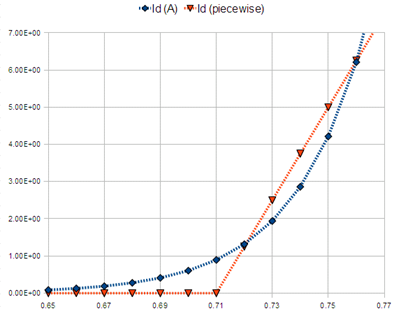
The cut- in voltage for silicon diode is approximately:
A) $0.2\,V$
B) $0.7\,V$
C) $1.1\,V$
D) $1.4\,V$
Answer
219.3k+ views
Hint: The silicon diode allows the accepting of the large electric current at a particular voltage called forward voltage. This is the cut- in voltage . Below this voltage, the diode does not allow the accepting of the current and after this the flow of current increases rapidly.
Complete step by step solution:
The silicon diode is made up of the silicon which has the two terminals in it. One of the terminal circuit elements minimizes the current flow in the one direction which is the reverse bias and in the other direction it carries the current easily which is known as the forward bias.

The $P$ type of the silicon diode possesses one extra hole in it. The battery in this diode is connected across the $p - n$ junction which makes the diode as the forward biased. Hence it pushes the electrons moves from the $n$ type to that of the $p$ type whereas the holes moves from the $p$ type to that of the $n$ type. This silicon diode requires $0.7\,V$ to start the forward biasing and this is known as the cut in voltage.
Thus the option (B) is correct.
Note: The semiconductors like germanium and the silicon are mainly used for the purpose of the diode. The germanium diode is more advantageous when compared to that of the silicon diode. Since the germanium diode requires only $0.3\,V$ to start forward biasing the diode. And the schottky requires only $0.2\,V$ for forward biasing.
Complete step by step solution:
The silicon diode is made up of the silicon which has the two terminals in it. One of the terminal circuit elements minimizes the current flow in the one direction which is the reverse bias and in the other direction it carries the current easily which is known as the forward bias.

The $P$ type of the silicon diode possesses one extra hole in it. The battery in this diode is connected across the $p - n$ junction which makes the diode as the forward biased. Hence it pushes the electrons moves from the $n$ type to that of the $p$ type whereas the holes moves from the $p$ type to that of the $n$ type. This silicon diode requires $0.7\,V$ to start the forward biasing and this is known as the cut in voltage.
Thus the option (B) is correct.
Note: The semiconductors like germanium and the silicon are mainly used for the purpose of the diode. The germanium diode is more advantageous when compared to that of the silicon diode. Since the germanium diode requires only $0.3\,V$ to start forward biasing the diode. And the schottky requires only $0.2\,V$ for forward biasing.
Recently Updated Pages
A square frame of side 10 cm and a long straight wire class 12 physics JEE_Main

The work done in slowly moving an electron of charge class 12 physics JEE_Main

Two identical charged spheres suspended from a common class 12 physics JEE_Main

According to Bohrs theory the timeaveraged magnetic class 12 physics JEE_Main

ill in the blanks Pure tungsten has A Low resistivity class 12 physics JEE_Main

The value of the resistor RS needed in the DC voltage class 12 physics JEE_Main

Trending doubts
JEE Main 2026: Application Form Open, Exam Dates, Syllabus, Eligibility & Question Papers

Understanding Uniform Acceleration in Physics

Derivation of Equation of Trajectory Explained for Students

Hybridisation in Chemistry – Concept, Types & Applications

Understanding the Angle of Deviation in a Prism

Understanding Collisions: Types and Examples for Students

Other Pages
JEE Advanced Marks vs Ranks 2025: Understanding Category-wise Qualifying Marks and Previous Year Cut-offs

Understanding Atomic Structure for Beginners

How to Convert a Galvanometer into an Ammeter or Voltmeter

Understanding Centrifugal Force in Physics

JEE Main Marking Scheme 2026- Paper-Wise Marks Distribution and Negative Marking Details

Degree of Dissociation: Meaning, Formula, Calculation & Uses




